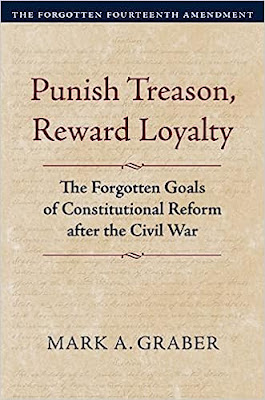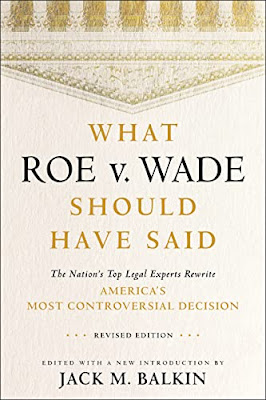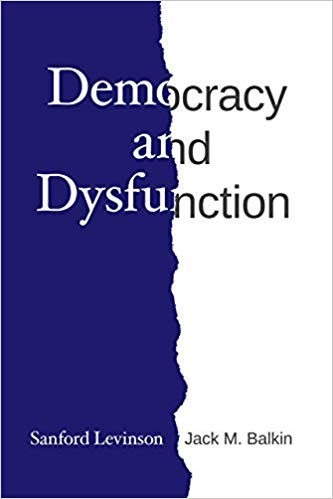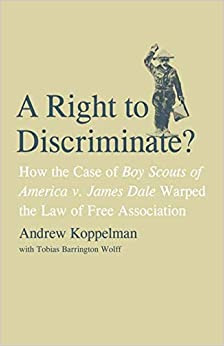Balkinization
an unanticipated consequence of
Jack M. Balkin
Balkinization Symposiums: A Continuing List
E-mail:
Jack Balkin:
jackbalkin at yahoo.com
Bruce Ackerman
bruce.ackerman at yale.edu
Ian Ayres
ian.ayres at yale.edu
Corey Brettschneider
corey_brettschneider at brown.edu
Mary Dudziak
mary.l.dudziak at emory.edu
Joey Fishkin
joey.fishkin at gmail.com
Heather Gerken heather.gerken at yale.edu
Abbe Gluck abbe.gluck at yale.edu
Mark Graber
mgraber at law.umaryland.edu
Stephen Griffin
sgriffin at tulane.edu
Jonathan Hafetz
jonathan.hafetz at shu.edu
Jeremy Kessler
jkessler at law.columbia.edu
Andrew Koppelman
akoppelman at law.northwestern.edu
Marty Lederman
msl46 at law.georgetown.edu
Sanford Levinson
slevinson at law.utexas.edu
David Luban
david.luban at gmail.com
Gerard Magliocca
gmaglioc at iupui.edu
Jason Mazzone
mazzonej at illinois.edu
Linda McClain
lmcclain at bu.edu
John Mikhail
mikhail at law.georgetown.edu
Frank Pasquale
pasquale.frank at gmail.com
Nate Persily
npersily at gmail.com
Michael Stokes Paulsen
michaelstokespaulsen at gmail.com
Deborah Pearlstein
dpearlst at yu.edu
Rick Pildes
rick.pildes at nyu.edu
David Pozen
dpozen at law.columbia.edu
Richard Primus
raprimus at umich.edu
K. Sabeel Rahmansabeel.rahman at brooklaw.edu
Alice Ristroph
alice.ristroph at shu.edu
Neil Siegel
siegel at law.duke.edu
David Super
david.super at law.georgetown.edu
Brian Tamanaha
btamanaha at wulaw.wustl.edu
Nelson Tebbe
nelson.tebbe at brooklaw.edu
Mark Tushnet
mtushnet at law.harvard.edu
Adam Winkler
winkler at ucla.edu
Compendium of posts on Hobby Lobby and related cases
The Anti-Torture Memos: Balkinization Posts on Torture, Interrogation, Detention, War Powers, and OLC
The Anti-Torture Memos (arranged by topic)
Recent Posts
Goodling Written Statement
Just A Few Blogs
ACS Blog
Alas, a Blog
Althouse
Arts and Letters Daily
Atrios (Eschaton)
Bill of Health
Buzzflash.com
Buzz Machine
Cato at Liberty
Juan Cole (Informed Comment)
Concurring Opinions
The Constitution in 2020
Corrente
Crooked Timber
Daily Howler
Daily Kos
Dana Boyd
Brad DeLong
Digby (Hullabaloo)
Discriminations
Daniel Drezner
Kevin Drum (Mother Jones)
Electrolite
En Banc
Eunomia (Daniel Larison)
Fafblog
Michael Froomkin (Discourse.net)
GovLab (Beth Noveck)
Rick Hasen (Election Law)
History News Network
How Appealing
Ignatz (Sam Heldman)
The Importance of (Ernie Miller)
Infolaw
Instapundit
International Economic Law and Policy Blog
IntLawGrrls
Jacob Levy
Jesus' General
Jurisdynamics
The Kitchen Cabinet
Mark Kleiman
Law Blog Central
Larry Lessig
Lawyers, Guns and Money
Liberal Oasis
Brian Leiter's Law School Reports
The Leiter Reports
Marginal Revolution
Megan McArdle
Memeorandum
Metafilter
Mirror of Justice
The New Republic
Newseum
No More Mister Nice Blog
Brendan Nyhan
Opinio Juris
Orcinus
The Originalism Blog
Pandagon
Passport (Foreign Policy)
Overcoming Bias
Political Animal (Washington Monthly)
Political Theory Daily Review
Political Wire (Taegan Goddard)
The Poor Man
Virginia Postrel
Prawfsblawg
Public Reason
Jonathan Rauch
Raw Story
Redstate
ReligiousLeftLaw.com
Reporters Committee For Freedom of the Press
Reproductive Rights Blog
Rothman's Roadmap to the Right of Publicity
SCOTUS Blog
Seeing the Forest
Clay Shirky
The Shifted Librarian
The Situationist
Larry Solum (Legal Theory)
Andrew Sullivan
Talking Points Memo
Talk Left
Tapped
Tbogg
TechPresident
The Paper Chase (Jurist)
Tom Paine
Tom Tomorrow (This Modern World)
Eve Tushnet
Uggabugga
University of Chicago Law School Faculty Blog
Unqualified Offerings
The Volokh Conspiracy
War and Piece (Laura Rozen)
Wampum
Oliver Willis
Wonkette
Written Description
Matthew Yglesias
Yin
Your Choice of Feeds
1. XML
powered by
2. Atom Feed
3. RSS 2.0
Goodling Written Statement
Marty Lederman
is now posted.
Several interesting things. Perhaps foremost, she basically accuses DAG McNulty of perjuring himself before congressional committees in several respects, and of deliberately withholding from the Committee information about Senator Domenici's role in the removal of David Iglesias. With AG Gonzales having in essence blamed McNulty for the whole mess, and now this, it will be very interesting to hear what more McNulty has to say about all the other actors . . . now that they all seem to have decided to tap him as the fall guy.
Second, Goodling writes that her "understanding at the time" was that the AG's secret Order of March 2006, transferring the delegation of responsibility for career DOJ employment decisions from the DAG and Associate to the AG Chief of Staff and the White House Liason (Sampson and Goodling) -- which I discuss here -- "generally formalized the historical practice of the this Administration." In other words, those decisions had been fully politicized and removed from the aegis of the professionals long before the order was issued. "Generally." And yet the order was issued secretly, without distribution to the DAG and Associate. Hmmmm. This warrants follow-up.
Third, Goodling acknowledges that in deciding whom to hire for jobs as Assistant U.S. Attorneys (line prosecutors), her decisions "may have been influenced in part based on political considerations." She calls this a "mistake," but in response to questions from Rep. Scott, later conceded that "“I know I crossed the line of civil service rules." See TPM's account here.
Fourth, she acknowledges that she also "took political considerations into account in making recommendations for positions as Immigration Judges and members of the Board of Immigration Appeals, and she thought that was permissible because Kyle Sampson had told her that OLC "had provided guidance some years earlier indicating that Immigration Judge appointments were not subject to the civil service rules applicable to other career positions. In late 2006, however, the Civil Division "expressed concerns that the civil service rules might apply" to such immigration judges.
This is also an area for further investigation. Did OLC conclude that the civil service laws don't apply to immigration judges? If so, what was the theory? (I'm not aware of any such OLC Opinion; but that doesn't mean there isn't one out there somewhere. Anyone know offhand what the law is on this?) And how did the Civil Division come to express its concerns? On what grounds?
There's at least one other very interesting thing about her opening statement, too. More on that later. [UPDATE: See here.]
[UPDATE: As usual, Hilzoy's impressions of the testimony, and of Goodling, are more incisive than anyone's.]
Posted
1:49 PM
by Marty Lederman [link]
Please provide your source for that assertion.
I don't know if you're deliberately misreading Marty's comment, but I'll charitably assume you're doing it accidentally. Marty mentioned that Ms. Goodling admitted that she may have checked on the political affiliations of Assistant United States Attorneys. Appointments to those positions, unlike appointments to the U.S. Attorney positions, are supposed to be made on a non partisan basis. Thus, the political affiliations of Clinton's nominees for U.S. Attorney positions, whatever those affiliations might have been, are totally irrelevant.
http://www.clintonlibrary.gov/research.html http://www.nndb.com and http://www.google.com
profhsg:
You don't think any of Clinton's AUSA hires were Democrats either? As I understand Goodling's testimony, OLC had indicated that Immigration Judge appointments, for instance, were not subject to the civil service rules. On the waiver requests, it seems that Goodling is admitting "in a very small number of cases" that her decisions may have been influenced in part based on political considerations, and she regrets that mistake.
It's interesting that she's a much better witness than the Attorney General of the United States.
charles, 3:06 pm: "every Clinton U.S. Attorney I've looked up was indeed a Democrat"
(Emphasis added.) Those two claims are not the same. Why are you backpedaling? Is it because you were caught making a claim that you shamelessly pulled out of your hat?
If your main goal is to prove that you're a complete waste of time, and that only a fool would take any statement of yours at face value, you're doing a fine job.
How many weeks has it taken to find this one silly person who was honest enough to actually admit that :::gasp::: political considerations partially colored her hiring decisions?
Apparently they did not teach the class on selective amnesia during testimony when she attended Regent's Law School. I thought that was a mandatory class after the Clinton years...
"An that ye LIBERALS do conjure up ye Vasty Spirits of Culpabilitie, against ye Partye or President, avert their curses ye may, with the mighty name of CLINTON, CLINTON, CLINTON."
I can't quote more, as the Grimoire's contents have been known to drive readers into utter madness or despair; the original, I believe, is kept under lock and key in the rare books room of what used to be Miskatonic University, but is now Regent.
Nora M. Manella, Edmund A. Sargus, Jr., Joseph Preston Strom, Jr., Kendall Brindley Coffey, Larry Herbert Colleton, James Lamar Wiggins, and Kent Barron Alexander;
Mary Jo White, Betty Richardson, Zachary W. Carter, Patrick H. NeMoyer, James Patrick Connelly, John Thomas Schneider, and Janet Ann Napolitano;
Charles Robert Tetzlaff, William David Wilmoth, Gaynelle Griffin Jones, Karen Elizabeth Schreier,
Judith Ann Stewart, Walter Michael Troop, and Eric Himpton Holder, Jr.;
Stephen Charles Lewis, Vicki Lynn Miles-LaGrange, Thomas Justin Monaghan, John W. Raley, Jr., Randall K. Rathbun, Frederick W. Thieman, Michael Joseph Yamaguchi, and Paula Jean Casey;
Paul Kinloch Holmes, III, Lynne Ann Battaglia, Scott M. Matheson, Jr., Robert P. Crouch, Jr., David M. Barasch, Veronica Freeman Coleman, Edward L. Dowd, Jr., Helen Frances Fahey, Claude Harris, Jr., and Kathryn E. Landreth;
Jay Patrick McCloskey, Henry Lawrence Solano, Jon Ernest DeGuilio, Christopher Droney, Peggy A. Lautenschlager, Emily Margaret Sweeney, John Joseph Kelly, Carl Kimmel Kirkpatrick, Michael Rankin Stiles, Frances Cuthbert Hulin, Sherry Scheel Matteucci, and Alan D. Bersin;
James Burton Burns, Joseph Leslie Famularo, Walter Charles Grace, Michael David Skinner, Patrick Michael Patterson, Katrina Campbell Pflaumer, Charles Joseph Stevens, Don Carlos Nickerson, Stephen John Rapp, and Donald Kenneth Stern;
Rebecca Aline Betts, Robert Charles Bundy, Larry Herbert Colleton, Harry Donival Dixon, Jr., Lezin Joseph Hymel, Jr., David Lee Lillehaug, Kenneth Ray Oden, Paul Michael Gagnon, Mark Timothy Calloway, Walter Clinton Holton, Jr., and Kristine Olson Rogers;
Janice McKenzie Cole, Michael Hayes Dettmer, Saul A. Green, Stephen Lawrence Hill, John Marshall Roberts, Kent Barron Alexander, David D. Freudenthal, Sheldon Whitehouse, and Gregory Moneta Sleet;
Charles Redding Pitt, Faith S. Hochberg, John Michael Bradford, Thomas Joseph Maroney, Eddie J. Jordan, Jr., Joe Bradley Pigott, Charles R. Wilson, Steven Scott Alm, and Joe Bradley Pigott;
J. Don Foster, Patrick M. Ryan, James Allan Hurd, Jr., James William Blagg, Calvin D. Buchanan, J. Rene Josey, Donna A. Bucella, Loretta E. Lynch;
Wilma Lewis, Beverly Martin, Douglas Jones, Thomas Scott, Mary Lou Leary, and Sharon Zealey;
Byron Jones, Denise O’Donnell, Paul Warner, Scott Lasser, Paul Seave, Ellen Curran, Stephen Robinson, Richard Deane Jr., Alejandro Mayorkas, Robert Green, Harry Litman, and Jose Rivera;
Melvin Kahle, Gregory Vega, Thomas Strickland, Donna Bucella, Daniel French, Quenton White, Jackie Williams, Mervyn Mosbacker Jr., and Carl Schnee;
Daniel Webber Jr., Norman Bay, Steven Reed, Ted McBride, and Audrey Fleissig.
I also never said those were my "only" sources -- here are some more:
http://lawyers.martindale.com/marhub
http://www.nexis.com/research
http://www.congress.gov/nomis/
http://www.fec.gov
If it was committed by a GOP Administration, it is a high crime or misdemeanor.
If it was committed by the Clinton Administration, it is a coincidence from which we should moveon.org.
You are an idiot. US Attorneys - the ones in charge of the districts - are not covered by the Civil Service Act, and therefore, the President may lawfully take into consideration their political leanings in deciding whether to offer any of them a position (or more specifically, nominate them).
This is the complete sentence which contained "the first quote:"
I guess it must have been a big coincidence that all Clinton's U.S. Attorney nominations were Democrats then?
That's not just "a question." It's a question which happens to contain an unqualified assertion. The assertion is this: "all Clinton's U.S. Attorney nominations were Democrats." You stated that assertion as if it's an established fact that you're in a position to prove. But when you were asked to show proof, you essentially admitted you couldn't.
(By the way, your sentence is not even a real question. It's a statement disguised as a rhetorical question. The statement you were really making was this: 'I think it's no coincidence that all Clinton's U.S. Attorney nominations were Democrats.')
We already know you lack integrity. We just appreciate the way you keep proving it over and over again.
"if you can prove any were Republicans"
More pathetic backpedaling. You didn't say none of them were Republicans. You said they all were Democrats. Maybe you're pretending to be too thick to understand that those claims are quite different.
"http://www.fec.gov"
Maybe this is your way of telling us that anyone who ever supported a Dem candidate is fairly labeled as a Dem, in your world. Am I reading you right? Otherwise I can't imagine why you're mentioning fec.gov.
Speaking of gratuitous links, why did you mention martindale? It could be you understand it better than I do, but I can't find the place where it lists party registration.
Anyway, you have some truly amazing research skills. You've presented 129 names, and you seem to be claiming that you verified that they're all Democrats. Really? I picked just one (Michael Joseph Yamaguchi) and can't manage to verify that. Could you let us in on the secret and tell us how you figured out that Yamaguchi is a Democrat?
bart: "someone someplace who will have violated some law unrelated to the subject matter of the investigation"
As far as I can tell, "the subject matter of the investigation" is Bush's project to politicize the DOJ. Today Goodling admitted that she was so eager to politicize the DOJ that she was willing to break the law in order to do so. Only on Planet Bart would this be considered "unrelated."
"How many weeks has it taken"
The whole process would move much more quickly if the Bushist perpetrators were not chronic stonewallers and amnesiacs.
":::gasp::: political considerations partially colored her hiring decisions"
There would be nothing to ":::gasp:::" about if "political considerations partially colored her hiring decisions" with regard to political positions. Trouble is, "political considerations partially colored her hiring decisions" with regard to positions that, by law, are supposed to be non-political.
We already know that the rule of law means nothing to you, but we appreciate the way you keep reminding us.
Sure, Nomination: PN513-103 (originally hired as Assistant U.S. Attorney during the Carter Administration -- he's only constributed to Democrats per on-line search -- I don't know of any Republicans who ONLY contribute to Democrats, do you?)
Michael Joseph Yamaguchi, to be United States Attorney for the Northern District of California, Department of Justice; vice Joseph P. Russoniello, resigned.
Received: July 29, 1993
Referred: Senate Judiciary
Latest Action: September 30, 1993 - Confirmed by the Senate
Later recommended by Senator Feinstein (D-CA) for federal District Court Judge, Yamaguchi withdraws his name from consideration without comment amid speculation that Yamaguchi's decision is the result of controversy over a misstep in a drug prosecution case. Senator Boxer (D-CA) also gave him ringing endorsement. Yamaguchi admires Thomas Jefferson for his intellectual pursuits; Thomas Edison for his inventive mind; Cicero for his brilliance as an orator and writer; Harry Truman for his complexities; and Robert Kennedy for his lawyering and political bravado.
http://www.highbeam.com/doc/1P1-2354220.html
Again, I'm sure that is all just a big coincidence, and Yamaguchi is NOT really a Democrat. God forbid. We certainly can't make ANY reasonable inferences about all these ties to Democrats, can we? Wouldn't be prudent. Reasonable inferences only work when John Ashcroft is in a hospital.
Besides, you are an idiot. U.S. Attorneys - the ones in charge of the districts - are not covered by the Civil Service Act, and therefore, the President may lawfully take into consideration their political leanings in deciding whether to offer any of them a position (or more specifically, nominate them). We should have both listened to Alex in the first place.
That doesn't prove he's a Democrat. It's just circular as claiming that he must be a Democrat, since Clinton hired him.
"he's only constributed to Democrats per on-line search"
I found one contribution by Yamaguchi. He gave Dianne Feinstein $250 in 1996. Are you claiming he made other contributions?
"We certainly can't make ANY reasonable inferences about all these ties to Democrats, can we?"
It's possible he's a Dem. It's also possible he's an independent who leans Dem (a large category). He might even be a RINO. The problem is that you didn't say 'Clinton hired lots of people who have ties to Democrats.' You said, as if it were a proven fact, that "all Clinton's U.S. Attorney nominations were Democrats" (emphasis added). We see now that you're not in a position to prove that (you've admitted you haven't even researched them all). If you were an honest person, you would have said something like this: 'I've checked a bunch of his nominations, and they seem to be people with ties to Democrats.' There would have been nothing surprising (let alone improper) about that, so instead you made something up.
bart: "it was committed by the Clinton Administration"
You're suggesting that Bush simply did what Clinton had already done. Nice job pretending you don't understand the difference. Trouble is, Sampson himself admitted he understood the difference. He described the difference in an email to Miers (1/9/06):
Harriet, you have asked whether President Bush should remove and replace U.S. Attorneys whose four-year terms have expired. I recommend that the Department of Justice and the Office of the Counsel to the President work together to seek the replacement of a limited number of U.S. Attorneys.
The U.S. Code provides that each United States Attorney "shall be appointed for a term of four years . . . [and] shall continue to perform the duties of his office until his sucessor is appointed and qualifies." … Accordingly, once confirmed by the Senate and appointed, U.S, Attorneys serve for four years and then holdover indefinately (at the pleasure of the President, of course). In recent memory, during the Reagan and Clinton Administrations, Presidents Reagan .and Clinton did not seek to remove and replace U.S. Attorneys they had appointed whose four-year terms had expired, but instead permitted such U.S. Attorneys to serve indefinitely under the holdover provision.
(See link, pdf, pdf. Emphasis in the original.)
In other words, the prior practice, under Reagan and Clinton, was to install your crowd at the start, but then leave them in place. Reagan and Clinton both did this:
…historical data compiled by the Senate show the pattern going back to President Reagan. Reagan replaced 89 of the 93 U.S. attorneys in his first two years in office. President Clinton had 89 new U.S. attorneys in his first two years, and President Bush had 88 new U.S. attorneys in his first two years.
Then again, you probably don't trust LAT, so maybe you'd like it hear from those moonbats over at Fox News:
When the party in power changes hands in the White House, it is expected that the new president will fire all the sitting U.S. attorneys, as was the case for both Ronald Reagan in 1981 and Bill Clinton in 1993. President Bush, unlike Clinton and Reagan, did not fire all the attorneys en masse when he took office in 2001, and allowed a few to continue in their positions for several months. All were replaced with his own selections early in his administration, however.
It is very unusual for a president to fire U.S. attorneys who were his choices for the job.
In other words, Reagan and Clinton hired their own people, but then left them alone to do their job. This wasn't enough for Bush, though, so he developed his own innovation: that he would install his own people, just like Reagan and Clinton did, but then he would replace his own people if it turned out they weren't "loyal Bushies." Here's how this seems to have been defined: they weren't willing to support Rove's fraudulent voter-fraud allegations.
Here's the standard Bushist talking point on this subject:
news stories reporting that the Bush administration had considered firing all 93 U.S. attorneys across the country failed to mention that that is exactly what Bill Clinton did soon after taking office back in 1993.
That's how Brit Hume said it. And that's essentially what you're saying. Trouble is, that talking point is doubly fraudulent. First of all, it glosses over the fact that what Clinton did was no different than what Reagan did. More importantly, it glosses over the fact that what Bush did is quite different than what Clinton and Reagan did. Fox knows this. Even Gonzales' former chief of staff Sampson knows this. I think you know this, too, but you think you can get away with pretending you don't.
I would definitely be open to revising my statement if anyone can rebut the presumption they were registered Democrats.
Say, Charles, you misspelled "assertion". No charge for the editing.
Cheers,
Cheers,
Just in case you have trouble grasping what Arne said, I'll go over it again for you. There's a material difference between the following two statements:
A) They were all Democrats; I don't mind conveying the impression that this is a proven fact, and that I possess such proof.
B) I presume they were all Democrats; I think this is a reasonable inference, even though I don't have proof.
An honest person would have said B. You're something different, so you said A.
Speaking of presumptions, it's now reasonable for us to presume that all your future statements which appear in the form of A should actually be interpreted as B. Thanks for reminding us that your words are basically worthless.
"there would be nothing surprising (let alone improper) with all of them being Democrats either"
Exactly. Which raises the following question: why did you mention it, to begin with? Oh, right, we almost forgot: in your usual style of compound deception, you were falsely suggesting that USAs are civil service jobs. And that Goodling apply political considerations when hiring civil servants was no different than Clinton applying political considerations when hiring USAs.
This was quickly pointed out to you. But instead of taking responsibility for your deception, you made a pathetic attempt at misdirection.
Your practice is to be simultaneously misleading on so many levels at the same time that it takes a concerted effort to sort it all out.
"Sampson was obviously mistaken about the Clinton Administration -- or, are you prepared to accept all the rest of his testimony too?"
Sampson's statement which I cited was not part of his testimony. It was in an email he sent to Miers.
And he wasn't "obviously mistaken," anymore than LAT and Fox were "obviously mistaken" when they said essentially the same thing he did. You're just "obviously" blowing more smoke.
One more time: Fox said "it is very unusual for a president to fire U.S. attorneys who were his choices for the job" (emphasis added). That's what Bush did. Seven on the same day. And a bunch of others, too. For no apparent reason. Fox News and Kyle Sampson, Gonzales' chief of staff, both stated that this was essentially unprecedented. You claim they're wrong. Really? Prove it. Unless you want us to adopt the "presumption" that you're consistently a complete waste of time.
Again, the political affiliation is irrelevant, as your statement was about "US attorneys," but the original post was about "assistant US attorneys"--a whole different animal by the rules. So, yes, it would be illegal to consider their political affiliation in the hiring process.
Take a gander at the donations of assistant US attorneys during the Clinton administration, and you'll see that many of them are/were Republicans.
Now, here's your next research project: during the Clinton administration, how many candidates for the position of assistant US attorney weren't hired because they were Republicans?
"I mean, of course you'll find illegal activity if you look...."
If it was committed by the Clinton Administration, it is a coincidence from which we should moveon.org.
So if we reverse polarity, everything will be just fine, according to you?
There are still a few people concerned with what's ethical, as opposed to what fits your politics.
"Compound deception" huh? Just for asking simple questions and pointing out facts. Interesting.
Look, to be fair, I finally did find ONE Clinton U.S. Attorney who is a registered Independent (although I don't know what his registration was back when he was evaluated and nominated). So, I will no longer make the above claim (whether in the form of a question or not). Nothwithstanding, I have now double-checked all the names I've gathered to date above (NOTE: I don't know if these are ALL of Clinton's U.S. Attorney nominations either), so that one instance may just be the exception that proves the rule. Let me know if there are any other questions.
PMS:
For all those "non-political" jobs like Immigration Judge or assistant U.S. Attorneys, no one even answered my first qestion on that in this thread: "Is it illegal to ask whether they are members of the Federalist Society?" I don't think it is. What someone hiring cannot do is discriminate based on political affiliation. That is now being addressed on another thread dealing just with these kinds of issues: http://balkin.blogspot.com/2007/05/curious-case-of-goodling-and.html
As for your requested "next research project" I'm not even done with my first one! I will note that Melanie Sloan (the Executive Director of Citizens for Responsibility and Ethics in Washington) was indeed hired as an assistant U.S. Attorney during Clinton's term, although I'm going to just leave it up to your own judgment whether she's a Democrat or not:
1993: Nominations Counsel to the Senate Judiciary Committee under Joe Biden;
1994: Counsel for the Crime Subcommittee of the House Judiciary Committee for Charles Schumer;
1995 - 1998: Minority Counsel for the U.S. House of Representatives Judiciary Committee with John Conyers;
2003: approached by Norm Eisen to co-found CREW, which she ran single-handedly until 2005 when she began to be able to hire her own staff. CREW is counsel of record for the civil lawsuit filed by Joe Wilson and Valerie Plame. Until its demise, Sloan was a regular guest on Al Franken's show on Air America Radio.
http://www.msmagazine.com/winter2007/mostfearedwoman.asp
We are probably never going to agree that it was good when Clinton replaced U.S. Attorneys but bad when Bush did it. Can we at least agree on the facts that, second term, Clinton replaced MORE than seven who had been his initial choices for the job:
1) Audrey Fleissig replaced Edward L. Dowd, Jr.;
2) Steven Reed replaced Walter Troop;
3) Norman Bay replaced John Kelly;
4) Daniel Webber, Jr. replaced Patrick Ryan;
5) Quenton White replaced John Roberts;
6) Daniel French replaced Thomas Maroney;
7) Loretta Lynch replaced Zachary Carter; and
8) Donna A. Bucella replaced Charles R. Wilson.
That's just the first eight I picked out from above. Tere were, in fact, dozens of U.S. Attorneys replaced in Clinton's second term. No Congress investigated him on that though. They had their hands full with all the other investigations of Clinton.
http://findarticles.com/p/articles/mi_qa3942/is_200002/ai_n8882254/pg_2
Scary what you find on the Internet these days.
"# posted by Charles : 6:55 PM"
And, as we well know, we wouldn't have heard about Monica if any of those investigations of multiply-refuted fake "scandals" had turned up anything actionable.
"# posted by Charles : 3:25 PM"
It's so much easier to state what Gonzales testified to knowing:
That he didn't know anything. And, whatsmore, he still knows nothing.
On which you'll doubtless base an "rebuttable presumption" that such is evidence that he is supremely qualified to head the DOJ.
"1993: Nominations Counsel to the Senate Judiciary Committee under Joe Biden;
"1994: Counsel for the Crime Subcommittee of the House Judiciary Committee for Charles Schumer;
"1995 - 1998: Minority Counsel for the U.S. House of Representatives Judiciary Committee with John Conyers;
"2003: approached by Norm Eisen to co-found CREW, which she ran single-handedly until 2005 when she began to be able to hire her own staff. CREW is counsel of record for the civil lawsuit filed by Joe Wilson and Valerie Plame. Until its demise, Sloan was a regular guest on Al Franken's show on Air America Radio.
"http://www.msmagazine.com/winter2007/mostfearedwoman.asp
"# posted by Charles : 6:16 PM"
One fact about Melanie Sloan is uequivocal: she has ethics, therefore is able to act impartially. It was CREW which reported Jefferson (D-LA) to Congress, et al.
You made no mention of that fact -- ethicality -- because obviously not a coin among the small change with which you "reason".
One other point: Though it has been repeatedly pointed out to you that there are two categories of AGs -- AGs and Asst. AGs -- and that AGs are legitimately subject to selection on the basis of political position, but that Asst. AGs are not -- you have dishonestly continued to ignore that distinction.
Do you wonder why your ideological kith and kin are being kicked to the curb, and shoved back into the septic tank which, as a matter of self-respect, vomited them out to begin with?
Cara mengobati kanker dengan herbal, Cara mengobati kanker dengan tradisional, Cara mengobati kanker dengan alami, Cara mengobati kanker dengan cepat, Cara mengobati kanker stadium 3, Cara mengobati kanker stadium 4, Cara mengobati kanker stadium awal, Cara mengobati kanker stadium 2, Cara mengobati kanker stadium akhir, Cara mengobati kanker tanpa ke dokter, Gambar obat kanker yang ampuh, Gambar obat kanker yang ampuh, Obat kanker ampuh dengan singkong, Cara mengobati kanker stadium awal tanpa operasi, Obat kanker manjur dari tumbuhan, Cara mengobati kanker stadium 1 tanpa operasi, Obat kanker ampuh dengan daun sirsak, Cara mengobati kanker stadium 2 tanpa operasi, Obat kanker paling mujarab yang efektif, Cara mengobati kanker stadium 3 tanpa operasi, Cara mengobati kanker stadium 3, Cara mengobati kanker stadium 4 tanpa operasi, Obat kanker paling manjur 2016, Cara mengobati kanker stadium akhir tanpa operasi, Pengobatan kanker mujarab tanpa operasi, Cara pengobatan kanker yang manjur, Pengobatan kanker manjur dan aman, Cara pengobatan kanker yang mujarab, Cara pengobatan kanker tanpa operasi, Cara pengobatan kanker yang ampuh, Obat kanker mujarab tanpa operasi, Obat kanker manjur tanpa operasi, Obat De Nature
obat alami untuk mencegah kanker serviks
obat medis untuk kanker serviks
wwwobat kanker serviks
obat vaksin kanker serviks
obat untuk mengatasi kanker serviks
Tumbuhan untuk obat kanker serviks
Obat untuk menyembuhkan kanker serviks
obat untuk penderita kanker serviks
obat tradisional untuk kanker serviks
obat utk kanker serviks
obat untuk kanker serviks
obat tradisional utk kanker serviks
sirsak obat kanker serviks
obat sakit kanker serviks
hello world obat untuk kanker rahim stadium 3
obat herbal kanker rahim stadium 4
obat kanker rahim stadium 1 1
Obat kanker rahim stadium 2
Obat penyakit herpes kelamin pria
obat kanker serviks menurut dokter
Obat herbal kanker serviks pada umumnya
Obat tradisional kanker serviks paten
obat tradisional kanker serviks manjur
obat tradisional kanker serviks mujarab
obat tradisional kanker serviks ampuh
obat tradisional kanker serviks herbal ampuh
obat tradisional kanker serviks herbal mujarab
obat tradisional kanker serviks herbal paten
Obat tradisional kanker serviks herbal manjur
obat tradisional kanker serviks herbal
obat tradisional kanker serviks herbal spesial
obat kanker serviks manjur herbal khusus
obat kanker serviks manjur herbal khusus wanita
obat tradisional kanker serviks herbal ampuh
Obat kanker serviks manjur herbal khusus umum
obat tradisional kanker serviks herbal
obat herpes herbal alamiah
obat herbal tradisonal herpes genital ampuh
Obat herbal alamiah herpes genital
Books by Balkinization Bloggers

Linda C. McClain and Aziza Ahmed, The Routledge Companion to Gender and COVID-19 (Routledge, 2024)

David Pozen, The Constitution of the War on Drugs (Oxford University Press, 2024)

Jack M. Balkin, Memory and Authority: The Uses of History in Constitutional Interpretation (Yale University Press, 2024)

Mark A. Graber, Punish Treason, Reward Loyalty: The Forgotten Goals of Constitutional Reform after the Civil War (University of Kansas Press, 2023)

Jack M. Balkin, What Roe v. Wade Should Have Said: The Nation's Top Legal Experts Rewrite America's Most Controversial Decision - Revised Edition (NYU Press, 2023)

Andrew Koppelman, Burning Down the House: How Libertarian Philosophy Was Corrupted by Delusion and Greed (St. Martin’s Press, 2022)

Gerard N. Magliocca, Washington's Heir: The Life of Justice Bushrod Washington (Oxford University Press, 2022)

Joseph Fishkin and William E. Forbath, The Anti-Oligarchy Constitution: Reconstructing the Economic Foundations of American Democracy (Harvard University Press, 2022)

Mark Tushnet and Bojan Bugaric, Power to the People: Constitutionalism in the Age of Populism (Oxford University Press 2021).

Mark Philip Bradley and Mary L. Dudziak, eds., Making the Forever War: Marilyn B. Young on the Culture and Politics of American Militarism Culture and Politics in the Cold War and Beyond (University of Massachusetts Press, 2021).

Jack M. Balkin, What Obergefell v. Hodges Should Have Said: The Nation's Top Legal Experts Rewrite America's Same-Sex Marriage Decision (Yale University Press, 2020)

Frank Pasquale, New Laws of Robotics: Defending Human Expertise in the Age of AI (Belknap Press, 2020)

Jack M. Balkin, The Cycles of Constitutional Time (Oxford University Press, 2020)

Mark Tushnet, Taking Back the Constitution: Activist Judges and the Next Age of American Law (Yale University Press 2020).

Andrew Koppelman, Gay Rights vs. Religious Liberty?: The Unnecessary Conflict (Oxford University Press, 2020)

Ezekiel J Emanuel and Abbe R. Gluck, The Trillion Dollar Revolution: How the Affordable Care Act Transformed Politics, Law, and Health Care in America (PublicAffairs, 2020)

Linda C. McClain, Who's the Bigot?: Learning from Conflicts over Marriage and Civil Rights Law (Oxford University Press, 2020)

Sanford Levinson and Jack M. Balkin, Democracy and Dysfunction (University of Chicago Press, 2019)

Sanford Levinson, Written in Stone: Public Monuments in Changing Societies (Duke University Press 2018)

Mark A. Graber, Sanford Levinson, and Mark Tushnet, eds., Constitutional Democracy in Crisis? (Oxford University Press 2018)

Gerard Magliocca, The Heart of the Constitution: How the Bill of Rights became the Bill of Rights (Oxford University Press, 2018)

Cynthia Levinson and Sanford Levinson, Fault Lines in the Constitution: The Framers, Their Fights, and the Flaws that Affect Us Today (Peachtree Publishers, 2017)

Brian Z. Tamanaha, A Realistic Theory of Law (Cambridge University Press 2017)

Sanford Levinson, Nullification and Secession in Modern Constitutional Thought (University Press of Kansas 2016)

Sanford Levinson, An Argument Open to All: Reading The Federalist in the 21st Century (Yale University Press 2015)

Stephen M. Griffin, Broken Trust: Dysfunctional Government and Constitutional Reform (University Press of Kansas, 2015)

Frank Pasquale, The Black Box Society: The Secret Algorithms That Control Money and Information (Harvard University Press, 2015)

Bruce Ackerman, We the People, Volume 3: The Civil Rights Revolution (Harvard University Press, 2014)
Balkinization Symposium on We the People, Volume 3: The Civil Rights Revolution

Joseph Fishkin, Bottlenecks: A New Theory of Equal Opportunity (Oxford University Press, 2014)

Mark A. Graber, A New Introduction to American Constitutionalism (Oxford University Press, 2013)

John Mikhail, Elements of Moral Cognition: Rawls' Linguistic Analogy and the Cognitive Science of Moral and Legal Judgment (Cambridge University Press, 2013)

Gerard N. Magliocca, American Founding Son: John Bingham and the Invention of the Fourteenth Amendment (New York University Press, 2013)

Stephen M. Griffin, Long Wars and the Constitution (Harvard University Press, 2013)

Andrew Koppelman, The Tough Luck Constitution and the Assault on Health Care Reform (Oxford University Press, 2013)

James E. Fleming and Linda C. McClain, Ordered Liberty: Rights, Responsibilities, and Virtues (Harvard University Press, 2013)
Balkinization Symposium on Ordered Liberty: Rights, Responsibilities, and Virtues

Andrew Koppelman, Defending American Religious Neutrality (Harvard University Press, 2013)

Brian Z. Tamanaha, Failing Law Schools (University of Chicago Press, 2012)

Sanford Levinson, Framed: America's 51 Constitutions and the Crisis of Governance (Oxford University Press, 2012)

Linda C. McClain and Joanna L. Grossman, Gender Equality: Dimensions of Women's Equal Citizenship (Cambridge University Press, 2012)

Mary Dudziak, War Time: An Idea, Its History, Its Consequences (Oxford University Press, 2012)

Jack M. Balkin, Living Originalism (Harvard University Press, 2011)

Jason Mazzone, Copyfraud and Other Abuses of Intellectual Property Law (Stanford University Press, 2011)

Richard W. Garnett and Andrew Koppelman, First Amendment Stories, (Foundation Press 2011)

Jack M. Balkin, Constitutional Redemption: Political Faith in an Unjust World (Harvard University Press, 2011)

Gerard Magliocca, The Tragedy of William Jennings Bryan: Constitutional Law and the Politics of Backlash (Yale University Press, 2011)

Bernard Harcourt, The Illusion of Free Markets: Punishment and the Myth of Natural Order (Harvard University Press, 2010)

Bruce Ackerman, The Decline and Fall of the American Republic (Harvard University Press, 2010)
Balkinization Symposium on The Decline and Fall of the American Republic

Ian Ayres. Carrots and Sticks: Unlock the Power of Incentives to Get Things Done (Bantam Books, 2010)

Mark Tushnet, Why the Constitution Matters (Yale University Press 2010)
Ian Ayres and Barry Nalebuff: Lifecycle Investing: A New, Safe, and Audacious Way to Improve the Performance of Your Retirement Portfolio (Basic Books, 2010)
.jpg)
Jack M. Balkin, The Laws of Change: I Ching and the Philosophy of Life (2d Edition, Sybil Creek Press 2009)

Brian Z. Tamanaha, Beyond the Formalist-Realist Divide: The Role of Politics in Judging (Princeton University Press 2009)

Andrew Koppelman and Tobias Barrington Wolff, A Right to Discriminate?: How the Case of Boy Scouts of America v. James Dale Warped the Law of Free Association (Yale University Press 2009)

Jack M. Balkin and Reva B. Siegel, The Constitution in 2020 (Oxford University Press 2009)
Heather K. Gerken, The Democracy Index: Why Our Election System Is Failing and How to Fix It (Princeton University Press 2009)

Mary Dudziak, Exporting American Dreams: Thurgood Marshall's African Journey (Oxford University Press 2008)

David Luban, Legal Ethics and Human Dignity (Cambridge Univ. Press 2007)

Ian Ayres, Super Crunchers: Why Thinking-By-Numbers is the New Way to be Smart (Bantam 2007)

Jack M. Balkin, James Grimmelmann, Eddan Katz, Nimrod Kozlovski, Shlomit Wagman and Tal Zarsky, eds., Cybercrime: Digital Cops in a Networked Environment (N.Y.U. Press 2007)

Jack M. Balkin and Beth Simone Noveck, The State of Play: Law, Games, and Virtual Worlds (N.Y.U. Press 2006)

Andrew Koppelman, Same Sex, Different States: When Same-Sex Marriages Cross State Lines (Yale University Press 2006)
Brian Tamanaha, Law as a Means to an End (Cambridge University Press 2006)
Sanford Levinson, Our Undemocratic Constitution (Oxford University Press 2006)
Mark Graber, Dred Scott and the Problem of Constitutional Evil (Cambridge University Press 2006)
Jack M. Balkin, ed., What Roe v. Wade Should Have Said (N.Y.U. Press 2005)
Sanford Levinson, ed., Torture: A Collection (Oxford University Press 2004)
Balkin.com homepage
Bibliography
Conlaw.net
Cultural Software
Writings
Opeds
The Information Society Project
BrownvBoard.com
Useful Links
Syllabi and Exams

